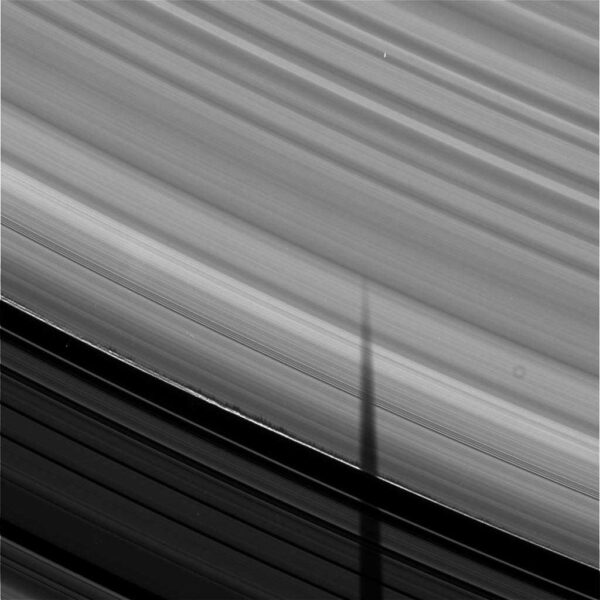A recent discovery blurs the line between amateurs and professionals.

NASA / JPL / Space Science Institute
In mid-April, some of the übergeeks who hang out on unmannedspaceflight.com noticed something remarkable. In a new Cassini image that shows the long, sharp shadow of Mimas, they saw a rough and chaotic fringe of dark shadow upon the edge of a bright ring just inside of a little ringlet. Are these the actual shadows of the long-sought objects within the rings?
For centuries we’ve been confident that the smooth-looking rings are really orbiting collections of billions of tiny moonlets. In Cassini’s stunning closest pictures from July 2004, the rings appeared strangely perfect, more like an idealized simulation than the real chaos of nature. We’ve known that at some closer scale the rings must eventually resolve into messy conglomerates of individual objects. Are we seeing them now?
After I received an e-mail from an excited colleague, directing me to the Planetary Society blog that linked back to the discovery posts, I posted the link myself on Facebook and soon saw that others had passed it on. Instant analysis ensued. The geometry and apparent size of the shadows suggest that the objects are several kilometers across — too large for individual ring particles but possibly clumps of smaller moonlets. This conforms to an idea that the rings might be collections of shifting clumps of smaller objects, weakly bound by gravity.
This discovery was made and publicized by “amateurs.” I use the word in its original sense, meaning “motivated by love.” Some contributors to this site are “professionals,” but nobody is getting paid. These lines are being blurred, to positive effect. Many scientists visit this site to learn what’s being said about new images. This fills a niche created by the easy availability of more imagery than the science teams can study themselves.
Decades ago, in the time of the Voyager flybys, there was a careful hoarding of new images, hierarchical access, and a more controlled release process. Transgressions were frowned upon and sometimes punished with professional opprobrium. Now we’re in an age of long-term reconnaissance with orbiters and rovers. Missions are no longer simply “encounters,” but committed relationships. Data rates are much higher, and the web makes it possible to release images instantly.
The best examples of this include the Mars Exploration Rovers (see page 22) and Cassini. This increases the value of having an army of amateurs go over everything with a loving and obsessive eye. Not only do we have an expanding network of electronic eyes in residence among the planets, and an instant global communications network to spread the riches around, but also a large brain trust of citizen-scientists scouring for anything interesting.
This growing, unfiltered, democratic branch of science is not without risk. There are kooky websites where wishful thinking and conspiracy theories reign, finding suppressed evidence of fossils and cities in every other image of Mars. You probably cannot have one without the other, and this inevitable looseness preserves an essential role for the standards of peer-reviewed science. But when something hugely significant is discovered and announced on a site like unmannedspaceflight.com, will the informed amateurs get credit for this discovery?
Individuals who discover things do not always receive the “official” credit. Sometimes that has to do with politics and power games, and sometimes with credit legitimately leaning toward those whose years of effort made the observation possible. The professional community should give some thought to how to acknowledge this new, self-assembling community of keen-eyed helpers, each themselves nodes in the evolving and complex ring of information and imagination girding our planet.
This article originally appeared in print in the July 2009 issue of Sky & Telescope. Subscribe to Sky & Telescope.
 0
0
Comments
You must be logged in to post a comment.